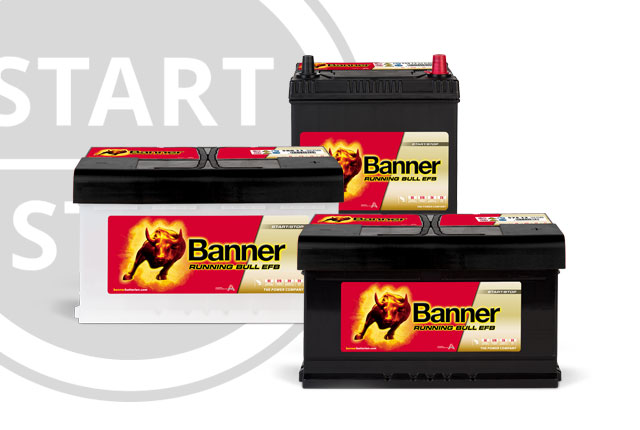WHAT IS AN EFB BATTERY?
BATTERY FOR START-STOP VEHICLES
Basically, two different battery technologies are used for vehicles with automatic start-stop systems,
depending on the energy requirements and necessary vibration or cycle stability.
- AGM (Absorbent Glass Mat): the acid is absorbed in the glass mat and cannot leak.
- EFB (Enhanced Flooded Battery): the cycle-proof starter battery with liquid electrolyte

EFB battery
- EFB - Enhanced Flooded Battery, the cycle-resistant starter battery with liquid electrolyte
- = AFB - Advanced Flooded Battery
- = ECM - Enhanced Cyclic Mat
- Running Bull EFB - Starter and on-board battery for vehicles with high energy requirements and simpler start-stop systems, or increasingly used as back-up batteries in electric cars
- for small cars up to upper middle class
- up to 270,000 engine starts
The EFB technology (Running Bull EFB/PRO) is mainly used for simpler start-stop systems, generally for vehicles with high energy requirements and for optimum on-board power supply stability. The Running Bull EFB battery is the optimal solution, primarily for small cars up to the upper middle class.
The EFB battery is a further development of the conventional wet-cell battery. Special mass additives and the use of a plate scrim (mat layer) provide the active material with additional support.
Differences to the AGM battery
- The EFB battery is in principle an optimised further development of the conventional wet battery.
- With the main advantages of improved charge acceptance and higher cyclic load when partially discharged.
- EFB batteries manage up to approx. 270,000 engine starts, in direct comparison up to approx. 360,000 starts with AGM batteries and max. up to approx. 120,000 starts with conventional wet batteries.
- Directly next to the engine block (combustion engine), the more heat-resistant EFB battery - with fitted thermal protection cover - is to be preferred if this was already installed ex works as the original battery.
Unbeatable user benefits
The battery reaches high vibration resistance and twice the cycle life (when compared to conventional starter batteries). Furthermore, the carbon additives lead to the charging time being significantly reduced. Up to 270,000 engine starts.
If energy recovery is also carried out in the vehicle (recovery of braking energy), the EFB battery works artificially at a lower state of charge (SOC State Of Charge at approx. 70%). Depending on the driving profile (short distance, stop-and-go, etc.), a conventional wet battery will be defective within a few months in this application due to the extremely high cyclic load.
PS: EFB batteries are also used in the commercial vehicle sector, especially in the long-distance HGV sector with the Buffalo Bull EFB battery variant, for high energy requirements due to increasing comfort functions and extreme vibration resistance with integral rear installation of the battery.
Changing an EFB battery
If a passenger car is equipped with an EFB battery as standard, it may be replaced with anEFB battery or under certain circumstances with an AGM battery. In an identical housing and of a similar performance class.
PS: Minor deviations in capacity or performance during a cold start have no effect on the safe start and the optimum power supply of the electrical system.
In a technology upgrade from EFB to AGM battery, some start-stop vehicles with battery management system (BMS) must be taught the new battery. The Banner Battery Service Tool (BBST) is ideal for this.
If you have any questions, please contact your Banner customer service representative, your Banner sales partner or contact us directly online.
Please note.
Never install a conventional wet-cell battery in a passenger vehicle with a start-stop function that is equipped with an Absorbent Glass Mat or AGM or EFB battery as standard.
EFB know-how in a nutshell
1. Replace EFB batteries with EFB batteries; upgrading to AGM batteries is possible! Never downgrade to conventional wet batteries. TIP! Directly next to the engine block (combustion engine), the more heat-resistant EFB battery—with a mounted thermal protection cover—is preferable if this was already installed as the original battery at the factory.
2. BEM compatible (battery energy management)
3. EBS/IBS compatible (electronic battery sensor/intelligent battery sensor)
EFB batteries are primarily designed for cars with start-stop functions and high energy requirements. Conventional wet batteries can no longer fulfil these requirements. Cars with a large number of additional electrical consumers, such as retrofitted parking heaters, also benefit from the higher cycle stability of EFB batteries.
Good to know! More and more electric cars are being fitted with 12V vehicle electrical system batteries with EFB technology, or can be upgraded in terms of battery technology.
Banner tip! EFB batteries are also ideal for vehicles with higher energy requirements, e.g. taxis and emergency vehicles of various blue light organisations.
More articles on this topic

